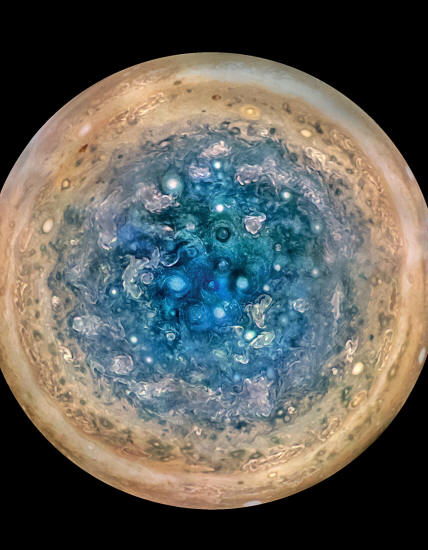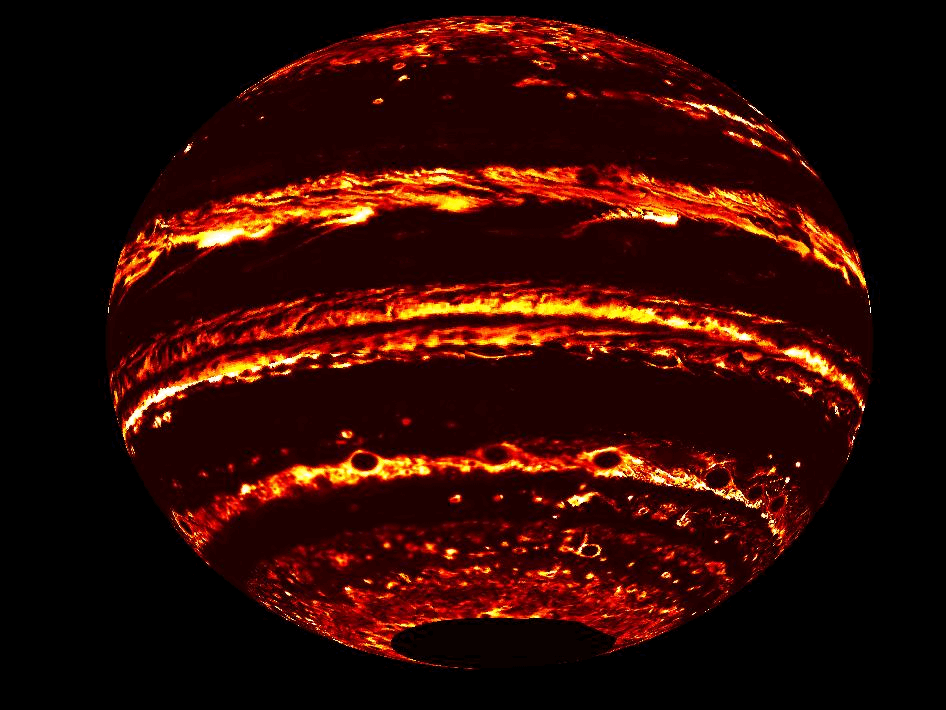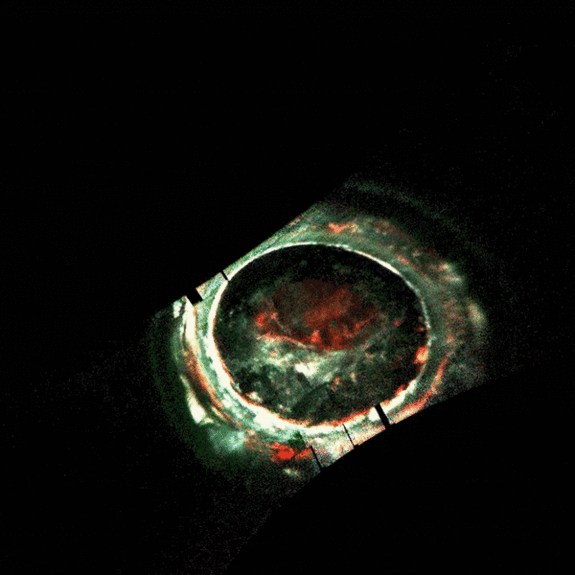|
Huge cyclones rage near Jupiter's mysterious poles, and the giant planet's powerful auroras are fundamentally different from Earth's northern and southern lights.
Those are just two of the discoveries made by NASA's Juno spacecraft during its first few close passes over Jupiter's poles, mission scientists report in two studies published online today (May 25) in the journal Science.
The south pole of Jupiter is seen from an altitude of 32,000 miles (52,000 kilometers) in this enhanced color mosaic of images from NASA's JunoCam. Cyclones up to 600 miles wide (1,000 km) are visible. Credit: NASA/JPL-Caltech/SwRI/MSSS Betsy Asher Hall/Gervasio Robles SCOTT BOLTON - 3
Lifting the veil on Jupiter
The $1.1 billion Juno mission launched in August 2011 and arrived in orbit around Jupiter on July 4, 2016.
Since then, the solar-powered spacecraft has been using eight instruments to study the gas giant's composition, interior structure, and gravitational and magnetic fields. It will continue to do this work, barring some sort of malfunction, through at least February 2018, the end of Juno's primary mission.
The mission's name is a nod to the Roman goddess Juno, who was able to look through the clouds to see her frequently misbehaving husband Jupiter, the king of the gods, who was hiding within.
Likewise, the Juno probe is peering beneath Jupiter's thick clouds to learn about the planet's formation and evolution - information that could shed light on the history of our solar system as a whole, NASA officials have said.
Juno makes most of the measurements relevant to this goal during its close flybys, which occur once every 53.5 days and bring the probe within about 3,100 miles (5,000 kilometers) of Jupiter's poles.
(The original mission blueprint called for Juno to maneuver to a less elliptical orbit and make these flybys every 14 days, but an issue with two helium valves in the spacecraft's propulsion system nixed that plan.)
GIF showing infrared emission from Jupiter, as observed by NASA's Juno spacecraft. Credit: S.J. Bolton et al., Science (2017)
Juno has now made five of these data-collecting "perijove passes."
The first came on Aug. 27, 2016, and the most recent occurred just last week, on May 19. The two new Science papers report results just from the first few flybys, as well as some measurements Juno made as it neared Jupiter in June 2016.
Before Juno, no spacecraft had ever gotten close-up looks at Jupiter's poles.
These mysterious regions are beautiful and bizarre, the Bolton-led study (Jupiter's Interior and Deep Atmosphere - The initial Pole-to-Pole passes with the Juno Spacecraft) reports.
It's unclear what, exactly, drives these polar cyclones, some of which are up to 870 miles (1,400 km) wide, or if they're stable over long periods, Scott Bolton said.
Juno also has been mapping out the concentration of water and ammonia deep within Jupiter's atmosphere.
Data gathered during the first few passes has revealed that ammonia abundances vary quite a bit from place to place - a discovery that surprised the mission team.
Juno's measurements during the first few close passes also show that Jupiter's magnetic field is nearly two times stronger than scientists had predicted.
And the probe's gravity data suggest that,
The southern lights of Jupiter, auroras at the planet's south pole, glow in this animation of false-color images from NASA's Juno spacecraft. The red hues suggest emissions from deeper in Jupiter's atmosphere, while green and white indicate higher regions. Credit: NASA/JPL-Caltech/SWRI
Otherworldly auroras
Earth's auroras result when the solar wind - charged particles streaming from the sun - slam into the planet's atmosphere, generating a glow. (Earth's magnetic field funnels these particles toward the poles, which explains the phenomenon's other name: the northern and southern lights.)
Scientists already knew that the solar wind is a major driver of Jovian auroras, and that the planet's rotation is involved as well.
But Juno has given researchers a chance to study the phenomenon in unprecedented detail; no other spacecraft had ever flown close to the planet's auroral regions before, Bolton said.
The second newly published Science study, (Jupiter's Magnetosphere and Aurora Observed by the Juno Spacecraft during its First Polar Orbits), which was led by John Connerney of the Space Research Corporation and NASA's Goddard Space Flight Center in Maryland, details what the Juno team learned about the auroras and Jupiter's magnetosphere from the initial perijove passes.
Once again, there were some surprises.
For example, the particles associated with Jupiter's auroras seem to be different than the ones responsible for Earth's most stunning light shows, study team members said.
Further close flybys should allow the Juno team to investigate such questions, he added.
|




